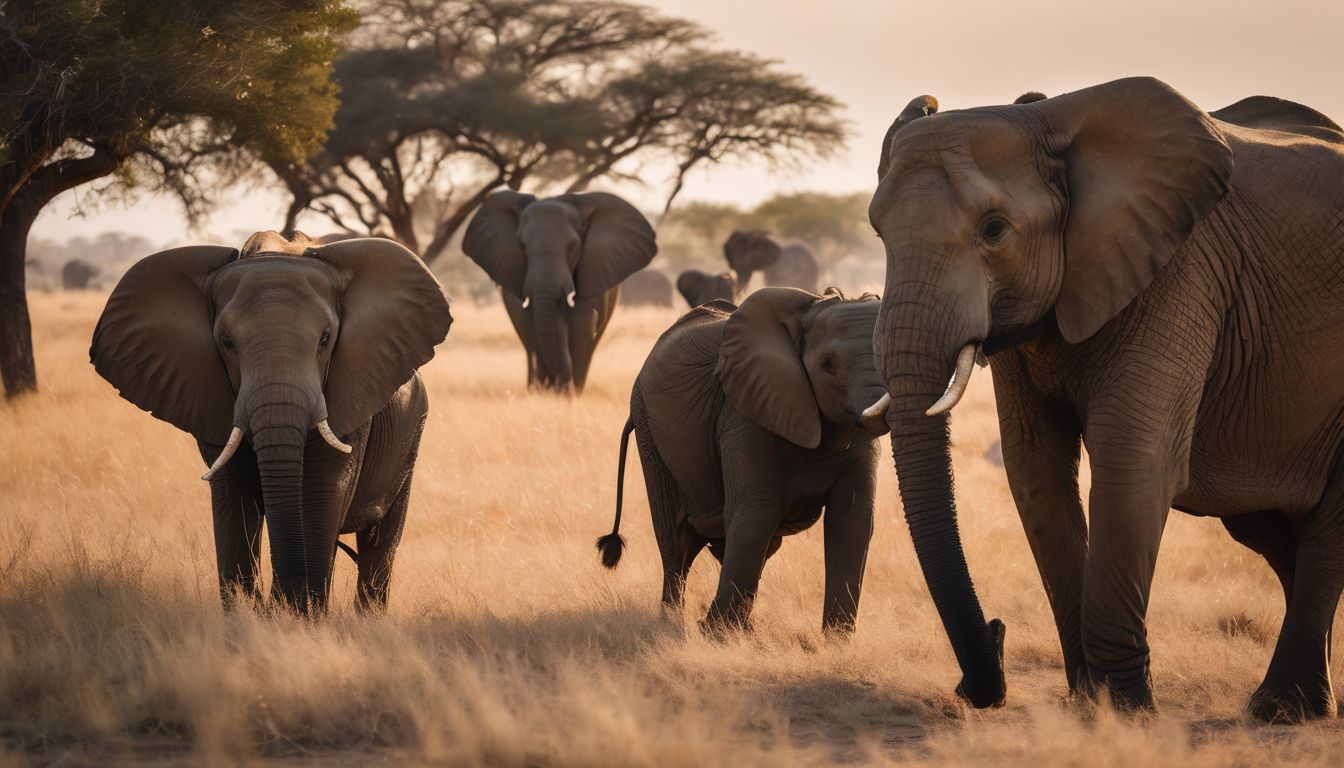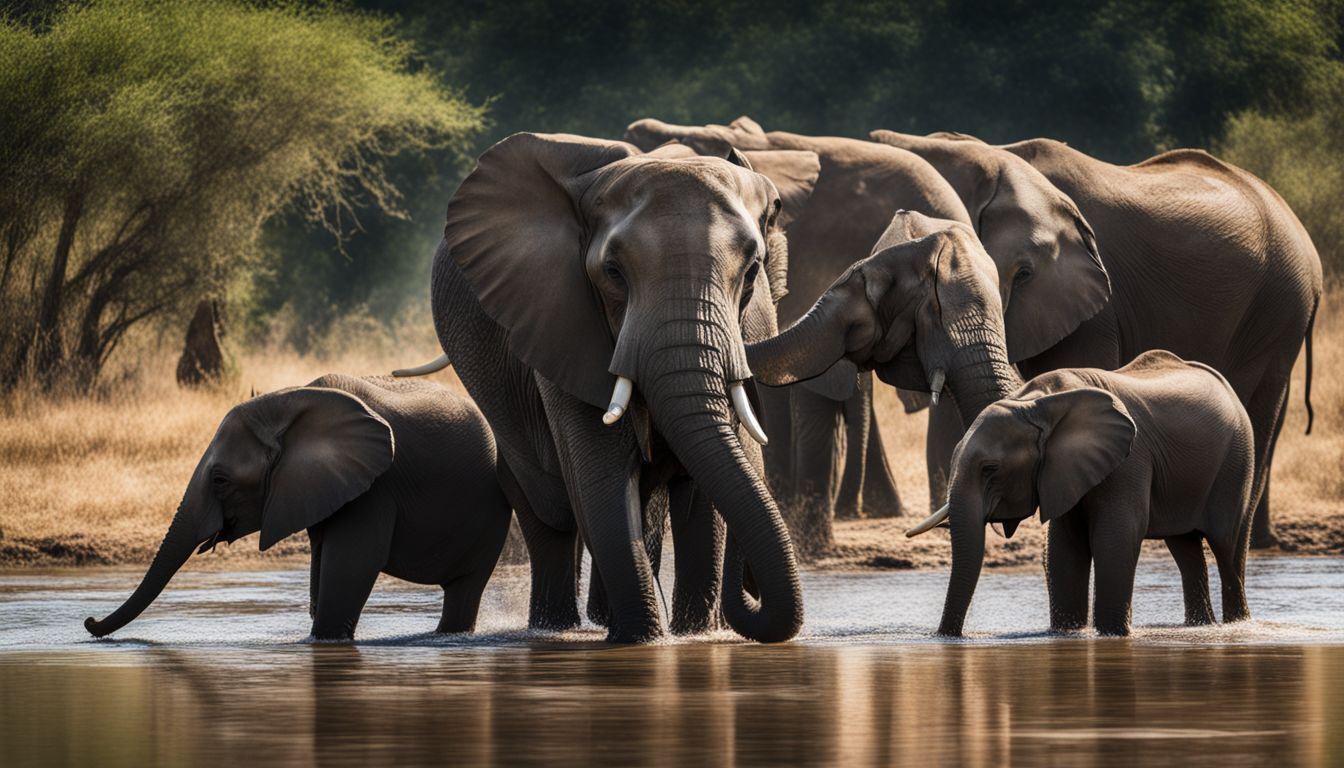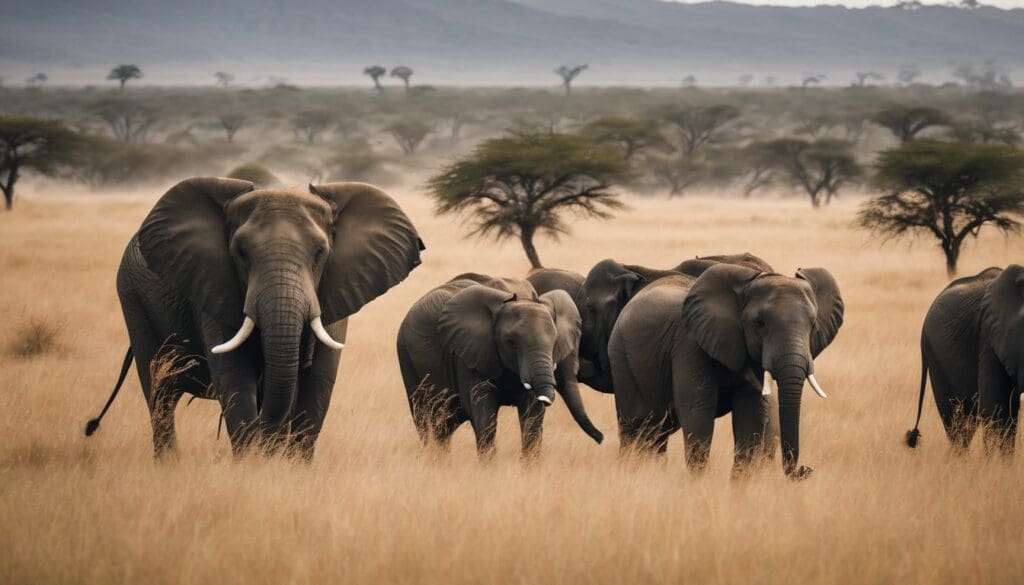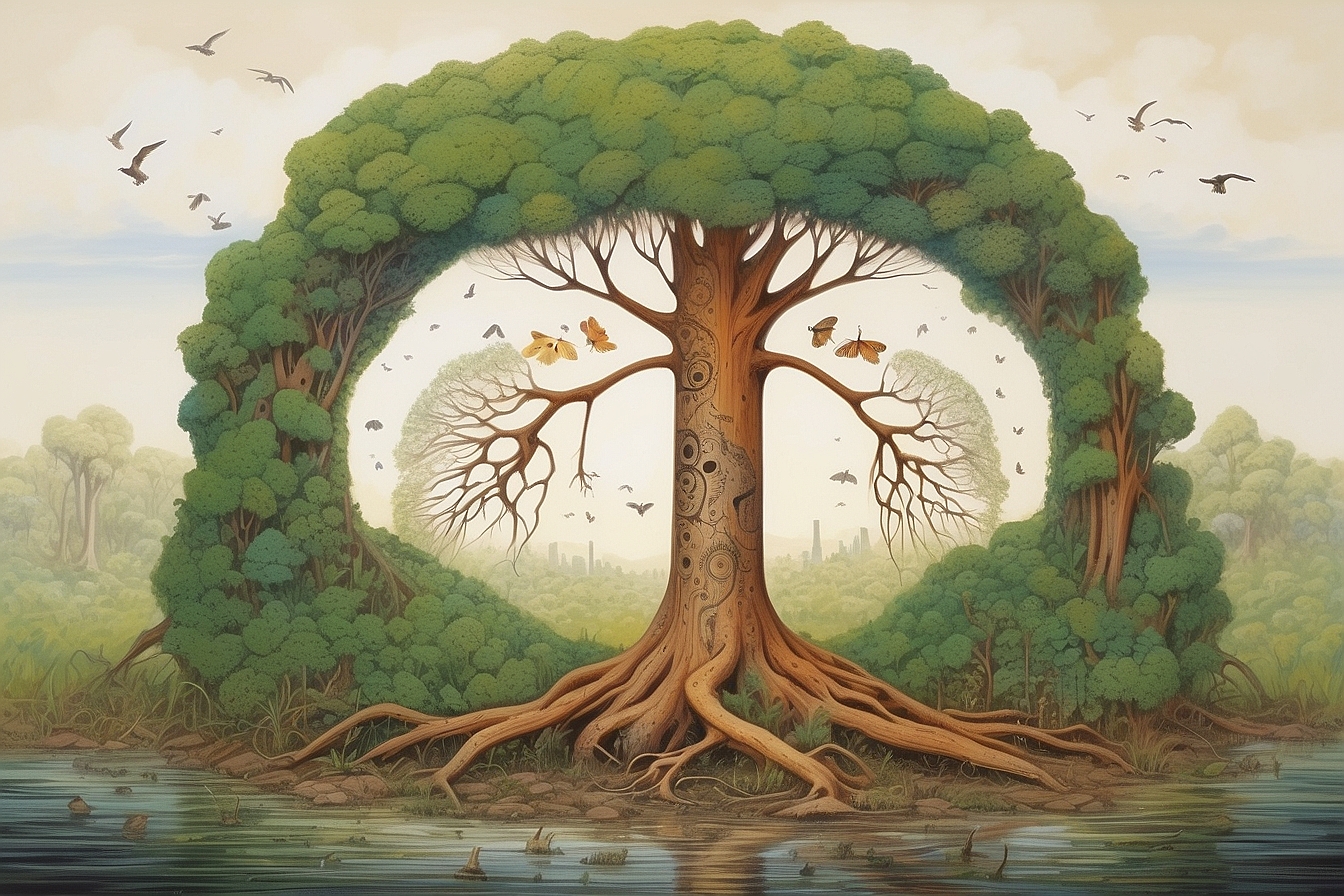Many of us carry a quiet concern for the future wellbeing of our planet, aware that there’s an elusive piece missing from nature’s harmonious puzzle. Indeed, this sentiment is echoed in conversations around kitchen tables and amongst friends in cosy coffee shops across the land.
Through our shared quest for knowledge, we’ve unearthed a rather astonishing truth: elephants are nothing short of vital custodians within their habitats. Our upcoming article delicately weaves the narrative of these dignified behemoths and their unsung role in nurturing our Earth’s diverse mosaic of life.
Prepare to embark on an enlightening voyage alongside these remarkable beings!
Key Takeaways
- Elephants are keystone species that significantly impact their habitats; they spread seeds, create watering holes and modify landscapes, which supports various life forms and promotes biodiversity.
- By trampling vegetation and altering land structures, elephants help in carbon sequestration which is important for reducing greenhouse gases in the atmosphere, thus playing a role in combating climate change.
- Protecting elephants from threats such as poaching and habitat loss is crucial; conservation efforts include securing protected areas for them to roam freely without human conflict and involving local communities in sustainable coexistence practices.
Role of Elephants in Ecosystems

Elephants are often celebrated for their grandeur, but it’s their remarkable influence on ecosystems that truly makes them giants of the environment. These keystone species shape their habitat in profound ways, from tending to the floral kingdom with their seed-spreading habits to sculpting the very landscape they roam through daily activities that sustain an array of other life forms.
Seed dispersal
We play a key role in maintaining healthy ecosystems, and part of that includes understanding how majestic creatures like African elephants contribute to the spread of vegetation. Their ability to disperse seeds across vast landscapes is vital for forest regeneration.
As they roam and feed, these giants ingest seeds from various plants and trees.
After digesting their meal, elephants deposit these seeds far away from their original location through their dung. This not only gives the seeds a chance to grow in new areas but also provides them with a nutrient-rich start thanks to the natural fertiliser found in elephant dung.
Dung beetles join in by breaking down these deposits further, helping to aerate the soil and promote seedling growth. Forest elephants, savanna elephants – regardless of the type – each fulfils this crucial function as ecosystem engineers reshaping forests and savannas alike.
Creation of watering holes
In their search for water, elephants use their tusks and trunks to dig deep into dry riverbeds. These actions create watering holes that benefit the entire ecosystem. Smaller animals come to these spots to drink, while predators find opportunities to hunt near them.
Elephants’ role in forming these vital sources of water showcases their importance as keystone species.
Our efforts in wildlife conservation must include protecting these gentle giants and the habitats they shape. By maintaining protected areas and mitigating human-elephant conflict, we ensure that savannah elephants continue to engineer the African landscape.
Their ability to transform parched land into thriving wetlands is essential for sustaining biodiversity and supporting a wide variety of plants and animals.
Landscape modification
Elephants shape their surroundings like no other animal, they’re true ecosystem engineers. Through their daily activities, these magnificent creatures alter the structure of forests and savannas.
They knock down trees to eat or create paths, which opens up dense areas and allows sunlight to reach the forest floor. This encourages new plants to grow and increases the diversity of habitat types in an area.
By transforming landscapes, elephants also create habitats for other species. As they trample through thick brush and undergrowth, they craft clearings that become home to a variety of animals and plants.
Their massive footprints can even evolve into small waterholes during the rainy season, providing vital resources for other wildlife. Let’s not forget how our conservation efforts play a critical role in sustaining these natural landscape architects who help maintain the balance of ecosystems we strive to protect.
Elephants as Ecosystem Engineers

Elephants are not just magnificent giants; they’re vital architects of their habitats, shaping the environment in profound ways. Their role extends far beyond sheer presence, as they actively engage in carving out ecosystems that support a myriad of other species.
Role in carbon sequestration
We often overlook the silent work elephants do in fighting climate change. These majestic animals play a vital role in carbon sequestration, which is just a fancy term for how nature locks away carbon dioxide from the atmosphere.
By simply going about their daily lives – feeding, moving across the land – they encourage dense vegetation growth. This is crucial because plants use photosynthesis to take in carbon dioxide and release oxygen.
Imagine an elephant pushing over a tree or trampling underbrush as it moves through forests and savannas. It might seem destructive, but these actions actually help shape ecosystems in ways that can store more carbon—in both vegetation and soil.
Dense woodlands become open areas where sunlight reaches smaller plants on forest floors, making them grow better and absorb more CO2. As ecosystem engineers, African savanna elephants break down woody plants while African forest elephants maintain forest density, each contributing uniquely to our planet’s health by increasing its ability to capture greenhouse gases.
Impact on climate change
Elephants play a critical role in fighting climate change, acting as ecosystem engineers. Their ability to sequester carbon is key to maintaining balance within their habitats. These gentle giants trample forests and dense grasslands, promoting the growth of smaller plants that store more carbon than large trees and bushes.
This natural process helps reduce the amount of carbon dioxide – a major greenhouse gas – in the atmosphere.
Our actions can either aid or hinder elephants in their crucial work against global warming. Protecting elephants from poaching and habitat loss allows them to continue shaping ecosystems efficiently.
Conservation areas become strongholds for biodiversity, where these keystone species can thrive and carry out ecological processes vital for a healthier planet. We must ensure sustainable futures for them so they can keep playing their part in mitigating the climate crisis.
Importance of Elephant Conservation
Recognising the plight of these majestic creatures is crucial; their survival mirrors the health of entire ecosystems. We must act decisively to preserve our shared home, ensuring that elephants thrive for generations to come.
Challenges faced by elephant populations
Elephants are up against immense obstacles. The illegal wildlife trade, especially for tusks, is pushing them towards extinction. We see poachers targeting these majestic creatures for their ivory, threatening not just individual animals but entire populations.
Habitat fragmentation further complicates their survival; as humans expand agricultural lands and build infrastructures, the once vast roaming grounds of elephants shrink alarmingly.
Human-wildlife conflict adds to their plight. Elephants often wander into human-populated areas in search of food and water, leading to conflicts that can be fatal for both sides. On top of this, lack of effective wildlife corridors restricts their natural migration patterns.
It’s our collective responsibility to tackle these issues head-on if we hope to ensure the future of elephants and the ecosystems they support.
Efforts to protect elephant habitats
We’re taking action to shield these magnificent creatures from the threats they face every day. Conservation teams work tirelessly to secure large tracts of land, ensuring elephants have the space they need to roam, feed, and thrive.
This includes expanding protected areas like the Kavango Zambezi Transfrontier Conservation Area, where borders fade away so wildlife can follow their natural migration patterns without coming into conflict with human activities.
It’s not just about setting aside land; it’s creating a safe haven for these giants and the countless other species that share their home.
Our strategies also involve collaborating with local communities who live alongside elephant habitats. We educate and empower them in sustainable practices that benefit both people and pachyderms.
By involving those who have shared this land for generations, we find holistic solutions that address human-elephant conflicts head-on. Creating buffer zones of nutritious grazing land helps keep elephants within safe areas while providing community benefits through eco-tourism ventures such as ecolodges which offer unique experiences like viewing herds traverse ancient pathways in Botswana or witnessing meerkats at dawn.
Let’s move forward now onto understanding how conserving elephants contributes tremendously to biodiversity preservation across ecosystems.
Conclusion
Elephants stand as mighty pillars of our ecosystems. Through their daily habits, these gentle giants shape the landscapes around them and bolster biodiversity. It’s essential that we act now to safeguard their future and by extension, the health of our planet.
Every step towards elephant conservation is a stride for environmental stability. Let’s commit to protecting these magnificent creatures for generations to come.
FAQs
1. What role do elephants play in ecosystems?
Elephants are ‘ecosystem engineers’ because they shape environments, create clearings in forests, disperse seeds and help to maintain the diversity of plants and animals.
2. Why are Asian and African elephants endangered?
Asian (Elephas maximus) and African elephants (Loxodonta africana), including the savannah elephant and the smaller forest cousin Loxodonta cyclotis, face threats from ivory trade, habitat loss, and wildlife crime leading to their status as endangered species.
3. How does the ivory trade affect elephant populations?
The demand for ivory tusks has fuelled illegal hunting which contributes greatly to declining numbers of these majestic creatures by prompting extinctions in some areas.
4. Can we do anything to save elephants from extinction?
Yes! Wildlife protection efforts like anti-poaching patrols, ending wildlife crime especially related to ivory markets, conserving habitats like rainforests or savannahs where they roam free are crucial ways we can help save them.
5. What is being done about wildlife crime targeting elephants?
Organisations such as the African Wildlife Foundation work tirelessly alongside local communities by enhancing security measures against poachers while also tackling the global trade of elephant ivory which threatens these iconic tuskers.
6. Are there any large-scale efforts tracking elephant populations?
Certainly! The Great Elephant Census was a significant effort dedicated to counting elephants across Africa; this helps researchers keep an updated record on numbers aiding conservationists with vital information necessary for protecting these flagship species.





